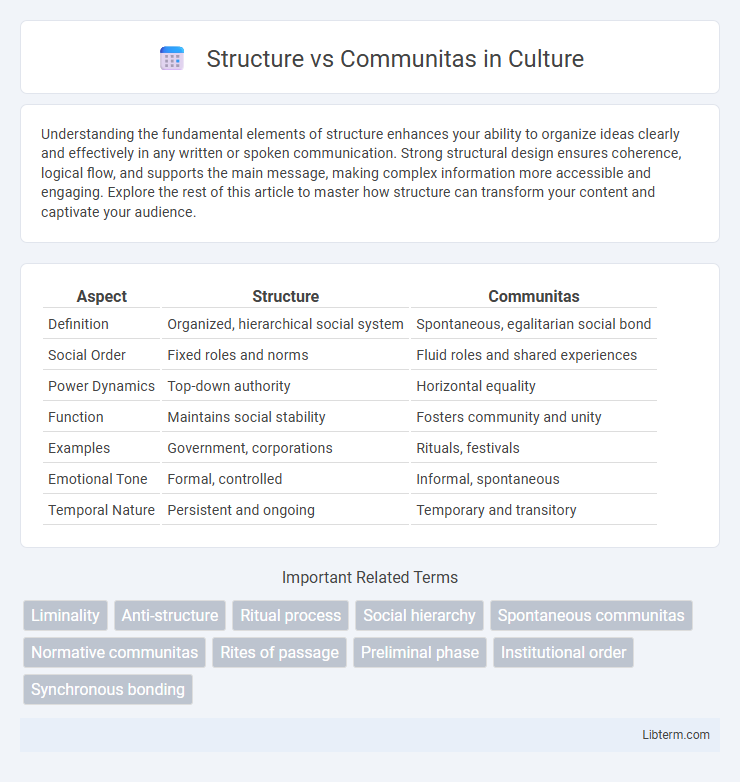Understanding the fundamental elements of structure enhances your ability to organize ideas clearly and effectively in any written or spoken communication. Strong structural design ensures coherence, logical flow, and supports the main message, making complex information more accessible and engaging. Explore the rest of this article to master how structure can transform your content and captivate your audience.
Table of Comparison
| Aspect | Structure | Communitas |
|---|---|---|
| Definition | Organized, hierarchical social system | Spontaneous, egalitarian social bond |
| Social Order | Fixed roles and norms | Fluid roles and shared experiences |
| Power Dynamics | Top-down authority | Horizontal equality |
| Function | Maintains social stability | Fosters community and unity |
| Examples | Government, corporations | Rituals, festivals |
| Emotional Tone | Formal, controlled | Informal, spontaneous |
| Temporal Nature | Persistent and ongoing | Temporary and transitory |
Defining Structure: Order and Hierarchy
Structure is characterized by established order and defined hierarchy that guide social roles and interactions within a system. It provides predictability and stability by assigning privileges, obligations, and authority across different levels. This systematic organization contrasts with communitas, which emphasizes spontaneous, egalitarian social bonding free from rigid constraints.
Understanding Communitas: Spontaneity and Unity
Communitas embodies a spontaneous and collective experience where individuals transcend social structures to achieve deep unity and equality. This phenomenon often emerges during rituals or crises, dissolving hierarchical distinctions and fostering shared humanity. Understanding communitas highlights its role in strengthening social bonds through unplanned, heartfelt interactions that contrast with the fixed roles found in structured societies.
Historical Origins of Structure and Communitas
The historical origins of structure trace back to classical social theories emphasizing formal institutions and hierarchical systems that organize societies through roles, rules, and authority. Communitas emerged from anthropological studies, particularly Victor Turner's work, highlighting spontaneous, egalitarian social bonds formed during rituals or liminal phases. These contrasting concepts reflect enduring dualities in social organization: rigid, institutional frameworks versus fluid, collective experiences.
Structure in Social Institutions
Structure in social institutions consists of established rules, roles, and hierarchies that organize societal functions and maintain order. These frameworks guide behavior through formal regulations and standardized procedures, ensuring predictability and stability in social interactions. Social institutions like governments, educational systems, and religious organizations exemplify structured order by enforcing norms that regulate individual and collective actions.
The Emergence of Communitas in Human Interaction
The emergence of communitas in human interaction highlights spontaneous, unstructured social bonds that dissolve hierarchical distinctions and foster collective unity. Unlike structured social systems defined by roles and norms, communitas arises naturally during shared experiences or rituals, emphasizing equal participation and emotional connections. This phenomenon plays a crucial role in reinforcing social cohesion and human empathy beyond formal institutional frameworks.
Structure vs Communitas: Core Differences
Structure represents the organized, hierarchical systems guiding social roles, norms, and behaviors, while communitas embodies spontaneous, egalitarian experiences that dissolve these social distinctions. Structure enforces order and predictability through defined rules and institutions, whereas communitas fosters collective unity and intense social bonding beyond structural constraints. The core difference lies in structure's emphasis on stability and regulation contrasted with communitas's focus on fluidity and shared human connection.
Benefits and Limitations of Structure
Structure provides clear roles, rules, and predictable processes that enhance efficiency, accountability, and stability within organizations and social systems. Its limitations include rigidity, resistance to change, and potential suppression of creativity and spontaneous collaboration. While structure supports order and scalability, it can hinder flexibility and the emergence of organic, shared community experiences.
Advantages and Challenges of Communitas
Communitas fosters intense social bonds and collective identity by breaking down hierarchical structures, promoting equality and shared experiences that enhance emotional connection and solidarity. Its advantages include increased group cohesion, heightened sense of belonging, and the potential for spontaneous creativity and support among members. Challenges arise from the temporary nature of communitas, difficulties in sustaining long-term organization, and potential conflicts when reintegrating into structured social norms.
The Dynamic Interplay between Structure and Communitas
The dynamic interplay between structure and communitas reveals how social frameworks influence collective experiences, while moments of communitas temporarily dissolve hierarchical boundaries, fostering deep social bonds and shared identity. Structured systems provide order and predictability, yet communitas emerges during liminal phases, creating opportunities for transformation and social renewal. This tension fuels social cohesion and change by balancing stability with spontaneous fellowship.
Implications for Modern Society and Transformation
Structure versus communitas highlights the tension between established social systems and spontaneous communal bonds, shaping modern society's evolution. Emphasizing structure often prioritizes order, hierarchy, and institutional stability, while communitas fosters egalitarianism, shared experiences, and collective identity, crucial for transformational social movements. Understanding this dynamic informs strategies for societal change, balancing governance with grassroots empowerment to drive inclusive transformation.
Structure Infographic

 libterm.com
libterm.com